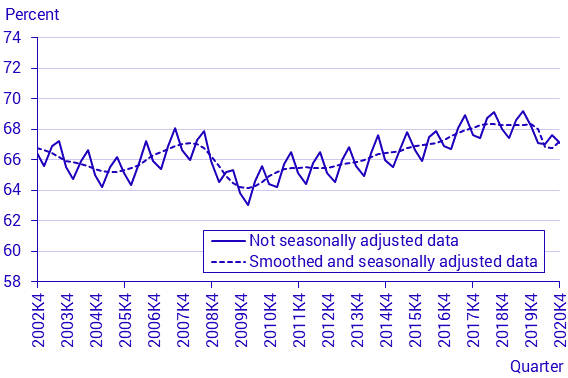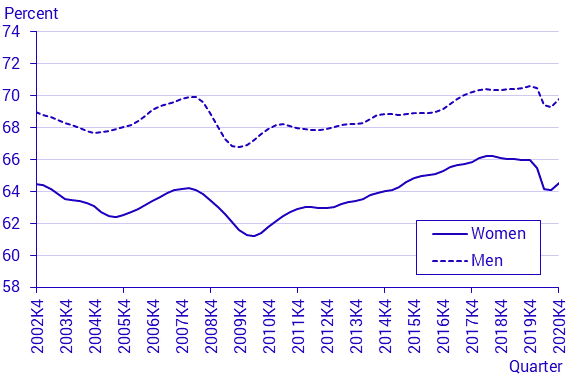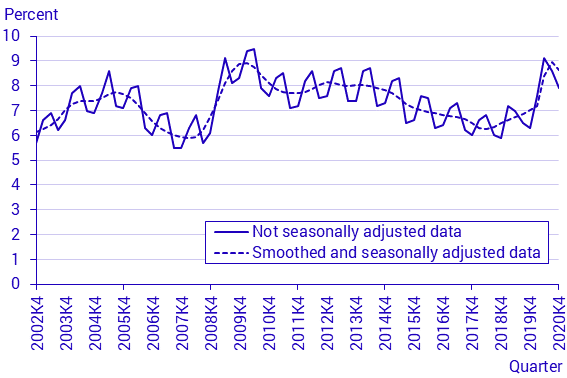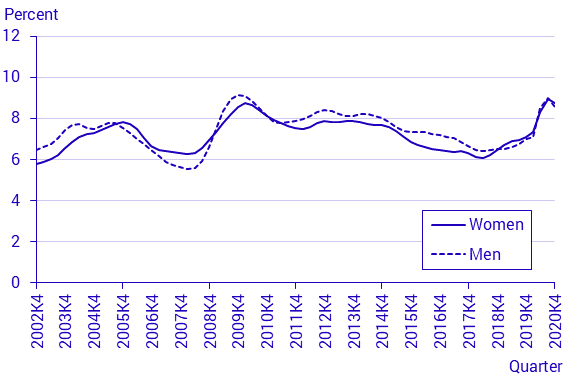Labour Force Surveys (LFS), 4th quarter 2020
Some recovery on the labour market in the fourth quarter 2020
Statistical news from Statistics Sweden 2021-02-09 9.30
In the fourth quarter of 2020, the employment rate among people aged 15–74 years was 67.1 percent, down by 1.1 percentage points compared with the same quarter a year ago. The unemployment rate increased by 1.6 percentage points and was 7.9 percent. The largest increase was among people aged 15–24 years and foreign born persons. The average weekly hours worked was 153.2 million hours, which corresponds to a decrease of 3.6 percent, calendar-adjusted. Seasonally adjusted and smoothed data indicates an improvement in the outlook on the labour market compared with the third quarter of 2020. At the same time, the labour market remains subdued compared with the first quarter of 2020, before the effects of the COVID-19 pandemic had any significant impact on the Swedish labour market.
The labour force
There were 5 494 000 people aged 15–74 years in the labour force in the fourth quarter of 2020, not seasonally adjusted. There were 2 588 000 women in the labour force, and the number of men increased by 39 000 compared with the corresponding quarter a year ago and amounted to 2 906 000. The relative labour force participation rate was 72.8 percent. For women it was 69.9 percent, and for men it was 75.7 percent, up by 0.9 percentage points. There were 549 000 young people aged 15–24 in the labour force, down by 34 000 compared with the fourth quarter of 2019. The relative labour force participation rate among young people was 47.6 percent, down by 2.9 percentage points.
Seasonally adjusted and smoothed data shows that there were 5 548 000 people in the labour force, which corresponds to 73.6 percent of the population. The labour force participation rate increased by 0.3 percentage points compared with the third quarter. The labour force participation rate is at the same level as in the first quarter of 2020, before the effects of the coronavirus (COVID-19) pandemic had any significant impact on the Swedish labour market.
Employment
In the fourth quarter of 2020, there were 5 059 000 people aged 15–74 years in employment, not seasonally adjusted, which is 71 000 fewer than in the corresponding quarter a year ago. There were 2 383 000 employed women, down by 60 000, and 2 676 000 employed men. The largest decrease in employment, based on the size of the group, was among young women aged 15–24 years. Among people aged 55–64 years, the number of employed persons increased by 31 000 to 951 000 compared with the fourth quarter of 2019. In most counties, there were no statistically significant changes in the number of employed persons, except in Västmanland County, where the number of employed persons decreased by 11 000, and amounted to 120 000.
The employment rate decreased by 1.1 percentage points and amounted to 67.1 percent. For women, the employment rate decreased by 1.8 percentage points and amounted to 64.3 percent, and for men the rate was 69.7 percent. For young people aged 15–24 years the employment rate was 37.9 percent, down by 3.9 percentage points compared with the fourth quarter of 2019. The employment rate also decreased for people aged 25–44 years.
Seasonally adjusted and smoothed data shows that there were
5 068 000 employed people, which is 38 000 more than in the third quarter of 2020. However, there are 55 000 fewer people employed than before the coronavirus (COVID-19) pandemic and its effects reached the Swedish labour market.
Employees
In the fourth quarter of 2020, there were 4 567 000 employees, not seasonally adjusted, which is a decrease of 58 000 compared with the corresponding quarter of the previous year. Among women, the number of employees decreased by 53 000 to 2 251 000, and among men there were 2 316 000 employees. There were 3 883 000 permanent employees, of whom 1 869 000 were women and 2 014 000 were men. The number of temporary employees decreased by 62 000 and amounted to 685 000. Among temporary employees, 382 000 were women, while among men, the number of temporary employees decreased by 36 000 and amounted to 303 000.
Compared with the third quarter of 2020, the number of employees increased by 43 000, according to seasonally adjusted and smoothed data. The number of employees decreased by 39 000 compared with the first quarter of 2020, before the effects of the coronavirus (COVID-19) pandemic had any significant impact on the Swedish labour market.
Hours worked
The total number of hours worked averaged 153.2 million per week, according to non-seasonally adjusted data in the fourth quarter of 2020. In calendar-adjusted figures, this corresponds to a decrease of 3.6 percent compared with the fourth quarter of 2019. The largest decrease was in the hotels and restaurants industry, in which the number of hours worked, calendar adjusted, decreased by 25.0 percent compared with the fourth quarter of 2019. In the personal and cultural services industry, the number of hours worked decreased by 12.8 percent and in education the number of hours worked decreased by 6.0 percent. The number of hours worked also decreased in the human health and social work industry.
Seasonally adjusted and smoothed data shows that total average hours worked amounted to 149.1 million hours per week, which is an increase of 1.5 million hours compared with third quarter of 2020. In 2020, weekly hours worked was at its lowest in the second quarter, and has since increased by 6.4 million hours. The number of total weekly hours worked decreased by 4.4 million hours compared with the first quarter, before the effects of the coronavirus (COVID-19) pandemic had any significant impact on the Swedish labour market.
The majority of employed persons have an agreed working time of 35 hours or more per week, that is, full-time work. In the fourth quarter of 2020, 3 922 000 people worked full time, which is 48 000 fewer than in the fourth quarter of 2019. Among full-time employed persons, 2 239 000 were men and 1 683 000 were women. In total, 352 000 people worked short part-time (1–19 hours) and 771 000 people worked long part-time (20–34 hours).
Average actual weekly hours worked among employed persons aged 15-74 years amounted to 30.3 hours in the fourth quarter of 2020. Average weekly hours worked amounted to 28.3 hours among women, and 32.1 hours among men.
At work and absence
There were 4 378 000 people employed and working in the fourth quarter of 2020, not seasonally adjusted. This corresponds to a decrease of 2.7 percent, calendar adjusted, compared with the corresponding quarter a year ago.
The LFS estimates the number of people who were absent during the whole week or parts of the week from their principal occupation, by main reason for absence. There were 1 654 000 people absent during the whole week or parts of the week in the fourth quarter of 2020, not seasonally adjusted. There were 693 000 people absent for the whole week, not seasonally adjusted. Among these people, 209 000 were absent due to holidays and 161 000 were absent due to illness. There were 25 000 people absent for the whole week due to lack of work, and 12 000 people were absent due to lay-offs.
It is common for people who are absent due to lack of work or lay-offs to be absent for only part of the week. There were 73 000 people absent for the whole week or part of the week due to lay-offs. The corresponding figure for people who stated lack of work as their main reason for absence was 66 000.
Seasonally adjusted and smoothed data shows that 4 288 000 people were at work, which is 63 000 more than in the third quarter of 2020. However, this is 25 000 people less than in the first quarter of 2020.
Underemployment
Among employed persons aged 15–74 years, 334 000 were underemployed in the fourth quarter of 2020, an increase of 55 000. The number of underemployed women increased by 30 000 to 166 000 and underemployed men increased by 25 000 to 168 000. Underemployed persons accounted for 6.6 percent of employed persons.
Unemployment
In the fourth quarter of 2020, there were 435 000 unemployed people aged 15–74 years, not seasonally adjusted, which is an increase of 91 000 people. This corresponds to an unemployment rate of 7.9 percent, which is an increase of 1.6 percentage points. There were 205 000 unemployed women, which is an increase of 41 000. The number of unemployed men was 230 000, which is an increase of 50 000. The unemployment rate increased by 1.6 percentage points to 7.9 percent among both men and women. Compared with the corresponding quarter last year, in percentage terms, the unemployment rate increased the most in Halland County and in Kalmar County. The unemployment rate increased by 3.8 percentage points to 7.9 percent in Halland County and by 3.5 percentage points to 9.0 percent in Kalmar County. The unemployment rate also increased in Västra Götaland County and in Stockholm County.
Among people aged 15–74 years, the number of unemployed people decreased by 15 000, according to seasonally adjusted and smoothed data, while the proportion of unemployed people decreased by 0.3 percentage points compared with the previous quarter. Compared with the first quarter of 2020, before the effects of the coronavirus (COVID-19) pandemic had any significant impact on the Swedish labour market, the number and the proportion of unemployed people both increased, by 82 000 people and 1.4 percentage points respectively. In the fourth quarter of 2020, there were 480 000 unemployed persons, which corresponds to an unemployment rate of 8.6 percent.
There were 125 000 long-term unemployed persons (unemployed for at least 27 weeks) aged 15–74 years in the fourth quarter of 2020, up by 22 000, not seasonally adjusted. Among long-term unemployed persons, 53 000 were women and 72 000 were men, which is an increase of 19 000.
There were 112 000 unemployed young people aged 15–24 years, not seasonally adjusted. This corresponds to a youth unemployment rate of 20.4 percent, up by 3.2 percentage points. Among unemployed youth, 65 000 were full-time students.
Among young people aged 15–24 years, seasonally adjusted and smoothed data shows a decrease in both the number and proportion of unemployed persons compared with the third quarter. The number of unemployed persons decreased by 12 000 and amounted to 144 000, and the unemployment rate decreased by 1.9 percentage points to 24.3 percent. Compared with the first quarter of 2020, the number of unemployed persons increased by 16 000 and the proportion of unemployed persons increased by 3.5 percentage points.
Not in the labour force
The group ‘not in the labour force’ includes people who are classified as neither employed nor unemployed. In the fourth quarter of 2020, this group consisted of 2 048 000 people, of whom 1 116 000 were women and 932 000 were men, down by 32 000 people compared with the fourth quarter of 2019. Among people outside the labour force, 909 000 were pensioners, while 703 000 were full-time students, an increase of 44 000. There were 223 000 people who reported that they were on long-term sick leave, a decrease of 32 000.
Latent job seekers
There were 160 000 latent job seekers aged 15–74 years in the fourth quarter of 2020. There were 85 000 women and 75 000 men who were latent job seekers. There were 93 000 latent job seekers among young people aged 15–24 years.
Unused labour supply
Unemployed persons, underemployed persons and latent job seekers together make up the unused labour supply. In the fourth quarter of 2020, the unused labour supply averaged 21.8 million hours per week, which is 5.2 million hours more than in the corresponding quarter a year ago. The unused labour supply corresponds to 545 000 full-time employments with a 40-hour working week.
Labour market for people aged 20-64 years
The relative labour force participation rate among people aged 20–64 years was 87.2 percent in the fourth quarter of 2020, not seasonally adjusted. Among women, the relative labour force participation rate was 84.3 percent and among men it was 89.9 percent. Seasonally adjusted and smoothed data shows that the labour force participation rate was 87.7 percent.
In the fourth quarter of 2020, the proportion of employed people aged 20–64 was 80.7 percent, not seasonally adjusted, which is 1.1 percentage points less than in the corresponding quarter a year ago. For women, this figure was 78.1 percent, down by 1.4 percentage points, and for men it was 83.2 percent, down by 0.9 percentage points. Seasonally adjusted and smoothed data shows that the employment rate was 80.8 percent, which is 0.8 percentage points less than in the first quarter of 2020. However, compared with the third quarter of 2020, the employment rate increased by 0.5 percentage points.
According to non-seasonally adjusted data, the unemployment rate in the age group 20–64 years was 7.4 percent, an increase of 1.6 percentage points compared with the fourth quarter of 2019. Among men, the unemployment rate increased by 1.6 percentage points to 7.5 percent and among women the unemployment rate increased by 1.7 percentage points to 7.4 percent. Compared with the first quarter of 2020, seasonally adjusted and smoothed data shows that the proportion of unemployed persons increased by 1.4 percentage points to 7.8 percent.
Swedish born and foreign born persons aged 20–64 years
In the fourth quarter of 2020, the relative labour force participation rate among Swedish born people aged 20–64 years was 88.7 percent, not seasonally adjusted. Among Swedish born women, the corresponding figure was 87.0 percent and among Swedish born men it was 90.3 percent. Among foreign born persons aged 20–64 years, the relative labour force participation rate amounted to 82.8 percent in the fourth quarter of 2020, which is an increase of 1.5 percentage points. The labour force participation rate was 76.9 percent among foreign born women and 88.6 percent among foreign born men. According to seasonally adjusted and smoothed data, the labour force participation rate was 89.3 percent among Swedish born persons, which corresponds to an increase of 0.3 percentage points compared with the previous quarter. Among foreign born persons the labour force participation rate was 83.0 percent, an increase of 0.3 percentage points compared with the previous quarter. Compared with the first quarter of 2020, before the effects of the coronavirus (COVID-19) pandemic were seen on the labour market, the labour force participation rate remained at a similar level among Swedish born persons, while the corresponding figure increased by 1.3 percentage points among foreign born persons.
In the fourth quarter of 2020, the proportion of employed persons among Swedish born persons aged 20–64 years was 85.1 percent, not seasonally adjusted. This corresponds to a decrease of 0.8 percentage points compared with the fourth quarter of 2019. Among Swedish born women the employment rate was 83.7 percent, which is a decrease of 1.3 percentage points, and among Swedish born men the employment rate was 86.4 percent. Among foreign born persons the employment rate was 67.9 percent. Among foreign born men the corresponding figure was 73.6 percent, while among foreign born women it was 62.1 percent. Seasonally adjusted and smoothed data shows that the employment rate increased by 0.5 percentage points to 85.4 percent among Swedish born persons, and by 0.7 percentage points to 67.6 percent among foreign born persons compared with the previous quarter. The employment rate decreased by 1.2 percentage points for foreign born persons and by 0.5 percentage points for Swedish born persons compared with the first quarter of 2020, before the effects of the coronavirus (COVID-19) pandemic had any significant impact on the Swedish labour market.
The relative unemployment rate among Swedish born persons aged 20–64 years was 4.1 percent in the fourth quarter of 2020, up by 1.0 percentage points. Among Swedish born women, the unemployment rate increased by 0.9 percentage points to 3.7 percent. Among Swedish born men, the unemployment rate increased by 0.9 percentage points to 4.4 percent. The unemployment rate among foreign born persons was 18.0 percent, an increase of 3.5 percentage points compared with the fourth quarter of 2019. Among foreign born women, the unemployment rate increased by 3.2 percentage points and amounted to 19.2 percent, and among foreign born men, it increased by 3.6 percentage points and amounted to 16.9 percent. According to seasonally adjusted and smoothed data, the unemployment rate decreased for both Swedish born persons and foreign born persons compared with the previous quarter, while it increased compared with the first quarter of 2020. Among Swedish born persons, the unemployment rate decreased by 0.2 percentage points compared with the third quarter of 2020, while it increased by 0.9 percentage points compared with the first quarter. Among foreign born persons, the unemployment rate decreased by 0.5 percentage points compared with the third quarter of 2020, while it increased by 2.8 percentage points compared with the first quarter. The unemployment rate was 4.4 percent among Swedish born people and 18.6 percent among foreign born people.




Definitions and explanations
Since the LFS is a sample survey, the results are subject to some uncertainty. The LFS basic tables contain uncertainty figures and refer to non-seasonally adjusted data.
Seasonally adjusted and smoothed data (trend values): data in which normal seasonal variations have been removed, then smoothed to reduce sampling error and short-term variations. Seasonally adjusted and smoothed data may be revised following new monthly outcomes and usually does not coincide with non-seasonally adjusted data. Seasonally adjusted and smoothed data is not to be compared with non-seasonally adjusted data.
More detailed results are available in the form of figures and tables on employed persons, hours worked, unemployed persons and more, on Statistics Sweden’s website.
Next publishing will be
2021-05-11 at 09:30.
Feel free to use the facts from this statistical news but remember to state Source: Statistics Sweden.
